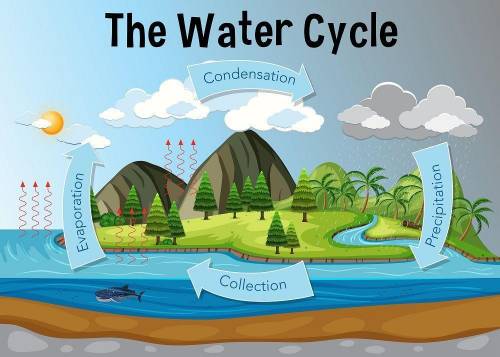
Assignment Instructions Step 1: For this project, you are expected to submit the following: 1. Your model of the water cycle 2. One to two typewritten paragraphs describing the water cycle Step 2: Prepare for the project. a) Read through the guide before you begin so you know the expectations of this project. Pay particular attention to the instructions you need to follow to create a model on your poster board. b) If anything is not clear to you, be sure to ask your teacher. Step 3: Gather materials for the model. a) Start with a blank poster board. Be sure to put your name on it. b) You may either draw the parts of the water cycle or print images to construct a model on your poster board. Gather any drawing tools that you will need, or print any images you want to use. Step 4: Create a model of the water cycle. a) Your model should include bodies of water such as lakes and oceans, organisms, air, and land. b) Draw arrows indicating how water moves within an ecosystem and between organisms and their environment. Be sure to include the Sun and gravity in your model. c) Include short phrases on your poster that summarize what occurs at each stage of the water cycle. Large poster board Markers, crayons, or colored pencils Scissors Glue or tape Student Guide Step 5: Write a paragraph describing the water cycle. a) Type one to two paragraphs describing the full water cycle. Be sure to use full sentences and proper grammar. b) Ask your teacher where you should save your work. Your teacher may also have specific guidelines about the file name you should use. Step 6: Evaluate your project using this checklist. If you can check each box below, you are ready to submit your project. Is your name on your poster board? Does your poster show bodies of water, organisms, air, and land? Did you draw arrows indicating how water moves within an ecosystem and between organisms and their environment including the role of the Sun and gravity? Did you include short phrases on your poster to summarize what occurs at each stage of the water cycle? Did you write one to two paragraphs describing the water cycle in full sentences? Step 7: Revise and submit your project. a) If you were unable to check off all the requirements on the checklist, go back and make sure that your poster and paragraphs are complete. b) Save your typewritten paragraph(s) for submission. c) Turn in your poster board to your teacher. Be sure that your name is on it. d) When your typed paragraph is complete, return to the Virtual Classroom, and use the “Add Files” option to locate and submit this portion of your assignment. Step 8: Clean up your workspace. a) Throw away any trash. b) Put away any materials that you used to create your poster. c) Congratulations! You have completed your project. as an answer send me a Picture of the project

Answers: 3


Other questions on the subject: Physics

Physics, 22.06.2019 06:30, jumpman2344
The coulomb's law explains which of the following? select all the force between two charged objects is inversely proportional to the charge on each object. the force between two charged objects is directly proportional to the charge on each object. the force between two charged objects is directly proportional to the distance separating them. the force between two charged objects is inversely proportional to the square of the distance separat coulomb's law is similar to newton's 2nd law. if the force between two objects is f and the charge on both objects is doubled, the new force between the would now be 2f. if the force between two objects is 2f and the distance separating them is doubled, the new force between the objects would now o the be zf.
Answers: 3

Physics, 22.06.2019 18:00, angie2118
Consider two regions of space containing a static electric field, region a and region b. in region a the equipotential lines are more closely spaced than those in region b. what can be said about the relative strength of the electric field in the two regions? a) the electric field in region a is stronger th
Answers: 3

Physics, 22.06.2019 19:30, u8p4
Water is siphoned from a large tank and discharges into the atmosphere through a 50-mm diameter tube. the end of the tube is b = 2.6 m below the tank bottom which is a = 6.7 m deep, and viscous effects are negligible. determine the maximum height h over which the water can be siphoned without cavitation occurring. atmospheric pressure is 101.4 kpa, and the water vapor pressure is 1.79 kpa (absolute). report your answer in meters to two decimal places.
Answers: 1

Physics, 22.06.2019 23:00, shelbybibb99
Acommon technique in analysis of scientific data is normalization. the purpose of normalizing data is to eliminate irrelevant constants that can obscure the salient features of the data. the goal of this experiment is to test the hypothesis that the flux of light decreases as the square of the distance from the source. in this case, the absolute value of the voltage measured by the photometer is irrelevant; only the relative value conveys useful information. suppose that in part 2.2.2 of the experiment, students obtain a signal value of 162 mv at a distance of 4 cm and a value of 86 mv at a distance of 5.7 cm. normalize the students' data to the value obtained at 4 cm. (divide the signal value by 162.) then calculate the theoretically expected (normalized) value at 5.7 cm.
Answers: 2
You know the right answer?
Assignment Instructions Step 1: For this project, you are expected to submit the following: 1. Your...
Questions in other subjects:


History, 31.08.2019 04:30




Arts, 31.08.2019 04:30


English, 31.08.2019 04:30


Social Studies, 31.08.2019 04:30




